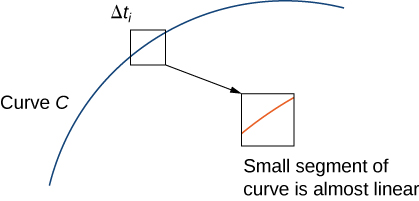| << Chapter < Page | Chapter >> Page > |
Note that in a scalar line integral, the integration is done with respect to arc length s , which can make a scalar line integral difficult to calculate. To make the calculations easier, we can translate to an integral with a variable of integration that is t .
Let for be a parameterization of Since we are assuming that is smooth, is continuous for all in In particular, and exist for all in According to the arc length formula, we have
If width is small, then function is almost constant over the interval Therefore,
and we have
See [link] .

Note that
In other words, as the widths of intervals shrink to zero, the sum converges to the integral Therefore, we have the following theorem.
Let be a continuous function with a domain that includes the smooth curve with parameterization Then
Although we have labeled [link] as an equation, it is more accurately considered an approximation because we can show that the left-hand side of [link] approaches the right-hand side as In other words, letting the widths of the pieces shrink to zero makes the right-hand sum arbitrarily close to the left-hand sum. Since
we obtain the following theorem, which we use to compute scalar line integrals.
Let be a continuous function with a domain that includes the smooth curve C with parameterization Then
Similarly,
if C is a planar curve and is a function of two variables.
Note that a consequence of this theorem is the equation In other words, the change in arc length can be viewed as a change in the t domain, scaled by the magnitude of vector
Find the value of integral where is part of the helix parameterized by
To compute a scalar line integral, we start by converting the variable of integration from arc length s to t . Then, we can use [link] to compute the integral with respect to t . Note that and
Therefore,
Notice that [link] translated the original difficult line integral into a manageable single-variable integral. Since
we have

Notification Switch
Would you like to follow the 'Calculus volume 3' conversation and receive update notifications?